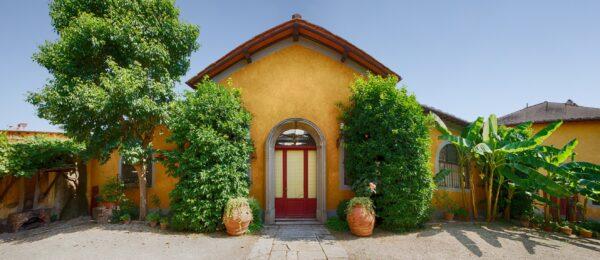Florence is a city of secrets. As you walk through the ancient streets, large wooden doors open, revealing monastic courtyards, previously unknown workshops, and fresco-filled entranceways. There’s always something new to discover.
On a sunny spring afternoon, therefore, I shouldn’t have been surprised to stumble across a hidden courtyard filled with tropical plants and sprawling vines set against sun-baked ocher walls, leading me to the oldest silk factory in Europe.

Unassuming doors open to a large space with sunlight pouring in from skylights high above, diffused by canopies that protect the delicate silk production below. The room is filled with machines, wooden structures, and complicated mechanisms singing a repetitive melody that echoes throughout.
Antico Setificio Fiorentino (ASF) is the best-kept secret in Florence, and still uses weaving machines that were built prior to the 19th century—one designed by the maestro Leonardo da Vinci.
Silk production was introduced to Italy sometime between the 9th and 11th centuries. According to ASF’s website, the art of silk weaving eventually found its natural home in the decadent city of Florence and “flourished in the 14th century, bringing prestige to the city and wealth to its merchants.” Florentine silk reached its peak during the reign of the Medicis, between the 15th and 16th centuries.

“To welcome the Grand Duke Cosimo to Florence, story tells that the streets were draped with ‘precious tapestries,’” the company’s history further recounts. Around the middle of the 18th century, some of the noble families “decided to establish a single workshop that would regroup all of the personal looms, patterns, and fabrics” previously located at their individual residences.
Each of the families had a share of the business, and the silk was made available to wealthy customers around the world. Over time, the Pucci family bought all of the shares, becoming the sole owner of the silk mill until it was bought by Stefano Ricci S.p.A. in 2010.
Although the company was established in 1786, ASF’s original looms—still in use today—are much older. Today there are 12 looms: six handlooms dating from the 18th century and six semi-mechanical looms from the 19th century.

Great art takes time, and as the oldest machines are driven by human force, in an eight-hour workday weavers can produce about 1 yard of damask, 2 yards of brocade, and just 6 inches of lampas, the company’s finest and most expensive fabric. The renaissance fabrics are used to decorate the most exquisite interiors in the world and have clothed noble families for centuries.
The unique warping machine, or “orditoio,” designed by da Vinci befits the Florentine silk factory (warp refers to the length of fabric). Before da Vinci’s invention, if a weaver wanted to make 100 yards of fabric, many threads of that length would have to be manually cut and aligned.

The warping machine has a large, wooden, cylindrical frame that makes it possible to prepare all the threads in a small space while maintaining tension. The machine spins like a giant spool, wrapping the threads around its circumference—a giant measuring machine that twirls elegantly and robustly.
Da Vinci was inquisitive, an expert problem solver, and a polymath who turned his hand to painting, drawing, sculpting, science, engineering, architecture, and anatomy. ASF’s treasured warping machine was built in the 1600s based upon his original design.

Jacquard fabrics are made with the help of a machine that was invented in 1804, now considered an important precursor to modern computers. It uses a punch card system—a series of holes and fills that give instructions for threads to go up or down in order to hide or seek—to create intricate patterns.
Modern versions are computer-controlled, but ASF still uses punch cards, preparing each card by hand. Before the Jacquard machine’s invention, a weaver would stand on top of the loom, pulling strings up or down to create patterns while the shuttle passed between the threads.

ASF silk was used for the restoration of the Tribuna of the Uffizi Gallery in Florence, and in the furnishings of the Villa Doria Pamphili in Rome. When the Royal Palace of Denmark in Copenhagen and the Royal Castle of Sweden in Stockholm were restored, they also used ASF silk.
In 1999, two rooms of the Kremlin were redecorated with help from Florence artisans; all of the fabrics came from ASF. The chairs had velvet embossed with the Kremlin star, the design singed into the fabric by a heated cylinder that still rests in a corner of the silk mill today. The restoration took two years, and all of the craftsmen came from Florence—world-renowned for having the best artisans.

The Setificio is a special place, so many different kinds of people have come to visit; it has always been this way, since it first opened. The King of Italy would buy fabrics from here, the noble families—it’s not a famous place, many people don’t know it exists, it is a place that attracted so many important people around the world, and still does today, even in modern times—Jeff Bezos was here recently. It’s unique and in the city centre, but many Florentines don’t have any idea it exists; it’s always been a kind of secret, you can’t tell from the outside—it’s good because it protects it. —Briza DattiAs she walked me around the factory, explaining the process from cocoon to Kremlin, I felt that I was being let in on an ancient secret, whispered among silk weavers for hundreds of years.

